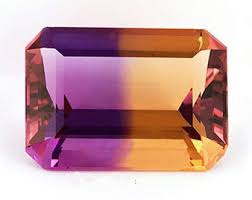Ametrine
 |
| Ametrine - evenly split Bi-colour |
Discovered only at the Anahi Mine in Bolivia comes a gemstone with a beautiful split personality.
Ametrine is possibly one of the most interesting and beautiful gemstones to become available on the global gem market during recent years.
Currently only found at the Anahi Mine in Eastern Bolivia, it is a fusion of the gorgeous regal purple of Amethyst and the warm sunshine hue of Citrine, beautifully combined in one stone. In the gem industry, Ametrine also goes by the name of ...